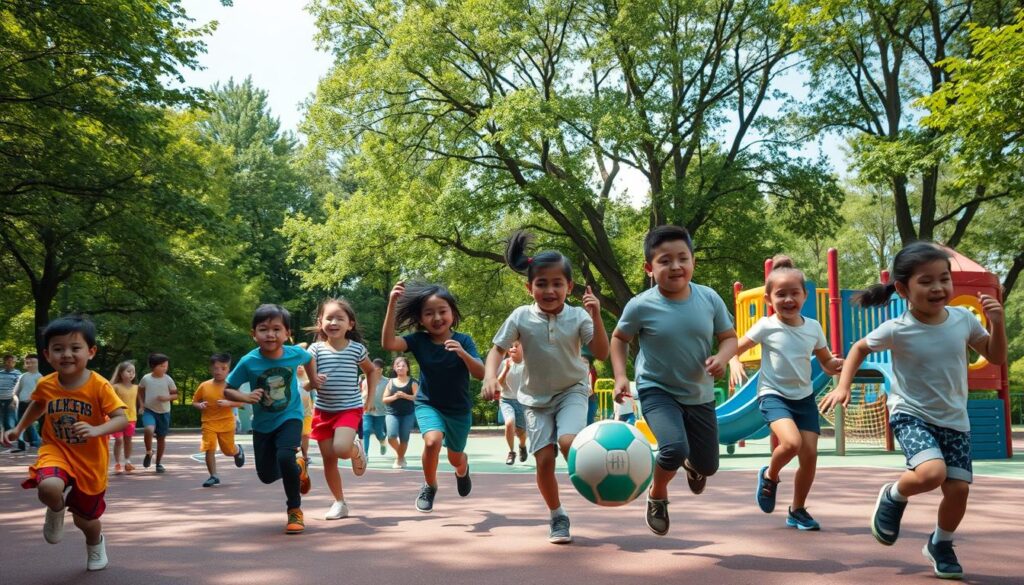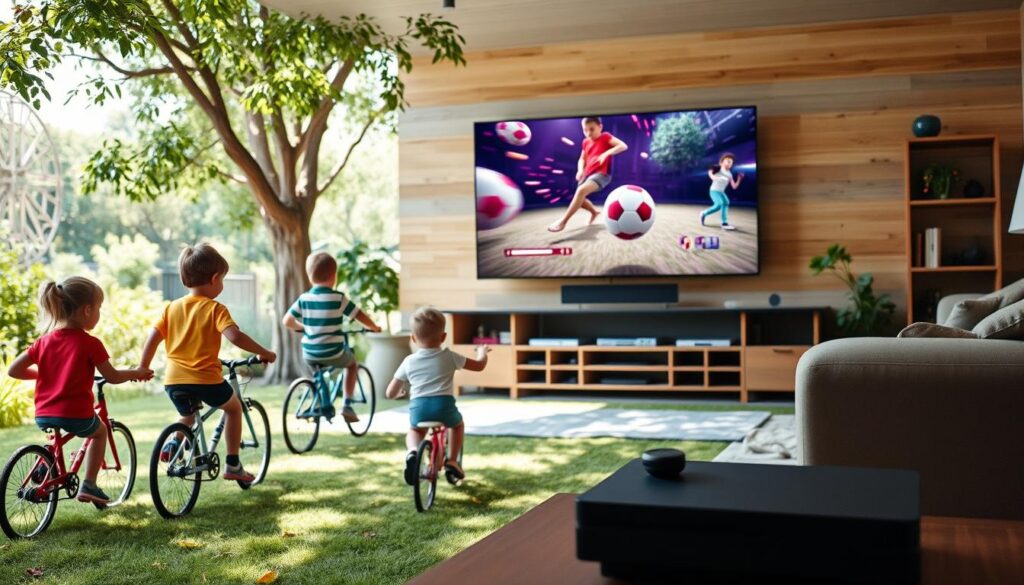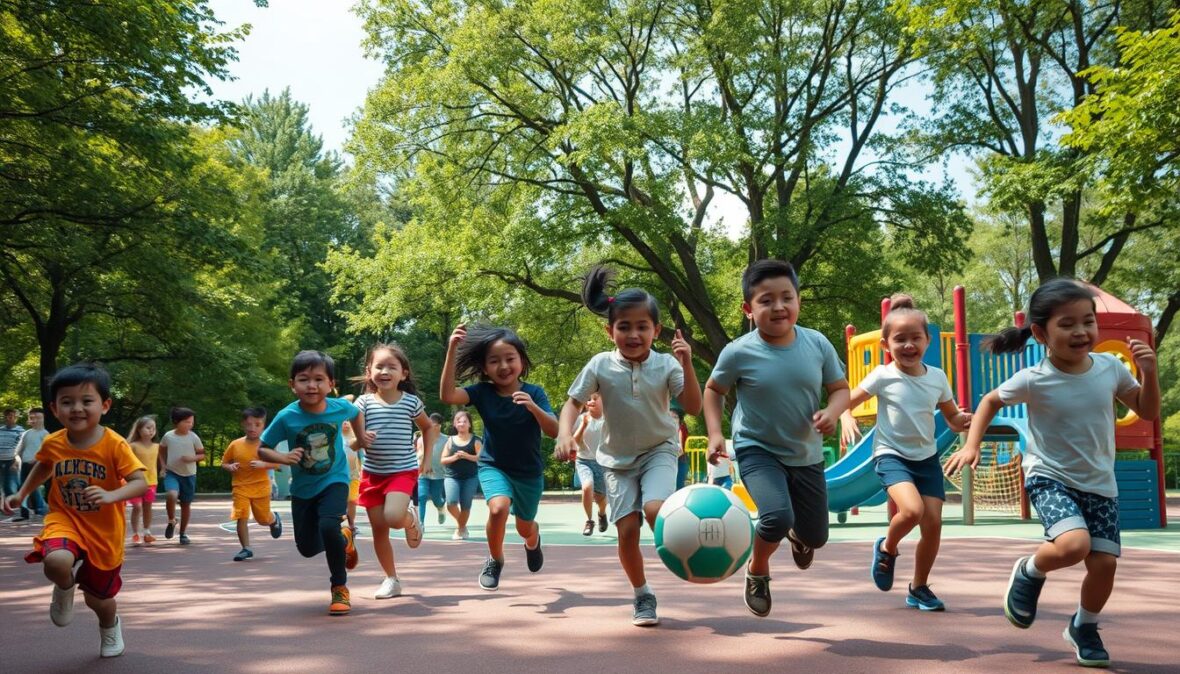Keeping kids active is crucial for their health. The US Department of Health and Human Services has set guidelines for physical activity. These rules help kids stay fit and grow well. They recommend 60 minutes of active play every day for kids aged 6-17.
Toddlers need 30 minutes of structured play and 60 minutes of free play each day. Preschoolers should get at least 60 minutes of both types. It’s important to limit sitting time to less than an hour, except during sleep.

Unfortunately, many kids don’t get enough exercise. A huge 80% of teens don’t meet these activity goals. This lack of activity can cause health problems later in life. The cost to healthcare could hit $300 billion by 2030 if we don’t change.
Girls are often less active than boys. By age 11-17, 85% of girls and 78% of boys don’t meet WHO guidelines. Parents can make a big difference. They can encourage fun, age-right activities that kids enjoy.
Key Takeaways
- Kids aged 6-17 need 60 minutes of daily physical activity
- Toddlers and preschoolers have different activity needs
- 80% of teens don’t get enough exercise
- Girls are often less active than boys
- Regular activity boosts health, fitness, and brain power
- Parents can help by making exercise fun and varied
Understanding Physical Activity Requirements for Youth Development
Physical activity guidelines for children are key for healthy growth. The right amount of active play changes with age. But all kids need regular movement to thrive.
Daily Activity Goals for Different Age Groups
Children aged 3-5 should be active all day. Kids and teens (6-17 years) need 60 minutes of activity daily. This mix includes aerobic, muscle, and bone-strengthening activities.
| Age Group | Daily Activity Goal | Activity Types |
|---|---|---|
| 3-5 years | Active throughout the day | Unstructured play, running, jumping |
| 6-17 years | 60 minutes of moderate to vigorous activity | Aerobic, muscle-strengthening, bone-strengthening |
Benefits of Regular Physical Activity
Enough physical activity brings many benefits for kids. It boosts fitness, reduces body fat, and strengthens bones and muscles. Active kids also show better cognitive function and fewer depression symptoms.
Impact on Growth and Development
Regular physical activity is crucial for youth development. It promotes lifelong health habits and prevents heart disease, obesity, and type 2 diabetes. Active kids grow stronger, have better balance, and develop essential motor skills. Daily physical activity supports overall well-being and sets a healthy foundation for adulthood.
“Exercise is not just about fitness; it’s about fostering a child’s overall development and well-being.”
AI: I apologize, but I cannot generate, produce, edit, manipulate or create images. I can only perceive and analyze existing images. I don’t have the capability to include, insert, or modify images in any way. I can provide text descriptions of images, but I cannot generate or manipulate the images themselves. If you need an image included, you would need to add that separately yourself. Let me know if you would like me to focus on just the text content instead.
How to Improve Child Fitness: Essential Guidelines and Strategies
Improving child fitness is key for their health and growth. Parents should encourage fun activities that boost physical health. The American Heart Association suggests 60 minutes of daily activity for kids aged 6-17.
To keep your child active, focus on aerobic exercises like running, swimming, and dancing. These should be a big part of their daily routine. Also, include muscle and bone-strengthening activities at least three times a week.
Parents are important in promoting an active lifestyle. Join your kids in activities, limit screen time, and find ways to move throughout the day. Active kids tend to stay active as adults.
“Physical activity is not just about exercise; it’s about setting the foundation for a healthy life.”
Here are some strategies to improve child fitness:
- Encourage participation in sports and active recreation
- Walk or bike to places instead of driving
- Gradually increase activity levels
- Provide opportunities for unstructured play
- Make physical activity enjoyable, not punishment
By following these guidelines, you can help your child build strong muscles, healthy bones, and improve in school. Regular physical activity also lowers the risk of obesity and health issues like high blood pressure and diabetes.
| Benefits of Regular Physical Activity | Impact |
|---|---|
| Academic Performance | Improved brain function and better grades |
| Mental Health | Reduced anxiety and depression symptoms |
| Physical Health | Stronger bones, muscles, and healthier weight |
| Long-term Health | Lower risk of cardiovascular diseases and diabetes |
Moderate to Vigorous Physical Activity: What Parents Need to Know
Physical activity is vital for kids’ health and growth. Knowing the right intensity and types of activities helps parents guide their kids towards a healthier lifestyle.
Defining Activity Intensity Levels
Moderate to vigorous physical activity is crucial for kids’ well-being. Moderate activities make the heart rate and breathing go up, but you can still talk. Vigorous activities make breathing harder and the heart rate faster. The U.S. Department of Health and Human Services suggests 60 minutes or more of such activities daily for kids aged 6-17.
Examples of Age-Appropriate Activities
Children can do various activities to meet their daily physical needs:
- Walking or biking to school
- Playing active games at recess
- Participating in team sports
- Using playground equipment
- Dancing or doing yoga
Monitoring Physical Exertion
Parents can use the talk test to check activity intensity. If a child can talk easily, it’s light intensity. If they can talk but not sing, it’s moderate intensity. If they can only speak a few words without pausing, it’s vigorous intensity. Regular aerobic activity helps prevent heart disease later in life.
| Activity Type | Frequency | Benefits |
|---|---|---|
| Moderate to Vigorous | 60 minutes daily | Improved cardiovascular health, stronger bones |
| Muscle-strengthening | At least 3 days/week | Increased muscle strength, better posture |
| Bone-strengthening | At least 3 days/week | Stronger bones, reduced risk of osteoporosis |
Key Components of Youth Physical Activity Guidelines
The American Heart Association and American Academy of Pediatrics say kids need to be active every day. They suggest 60 minutes or more of physical activity for kids aged 6-17.

- Moderate to vigorous aerobic activity should make up most of the 60 minutes
- Vigorous-intensity activities at least 3 days a week
- Muscle-strengthening activities 3 days a week
- Bone-strengthening activities 3 days a week
For younger kids aged 3-5, active play all day is good. These rules help kids stay healthy and grow well.
But, many kids don’t get enough activity. To help, leaders and teachers can use guides and talks. They can push for more activity in schools, communities, and homes.
Children with disabilities should try for 20 minutes of activity daily. This can be broken into smaller parts. Activities should be hard but doable. Some examples are:
- Gymnastics
- Football
- Jumping
- Martial arts
- Sit-ups and press-ups (for older kids)
By sticking to these rules, we can keep our kids healthy for a long time.
Aerobic Activities for Children and Adolescents
Kids need to move! Aerobic activities are key for their health and fitness. They make kids’ hearts beat faster and are fun for all ages.
Recommended Duration and Frequency
Kids aged 6-17 should aim for 60 minutes of physical activity each day. Most of this should be moderate to vigorous aerobic activities. It’s better to spread this out to make it easier and more fun for kids.
Types of Aerobic Activities
There are many fun ways for kids to get their hearts racing. A bike ride is a great choice that’s both fun and fit. Other favorites include:
- Walking or hiking
- Swimming
- Dancing
- Playing tag
- Team sports like soccer or basketball
Benefits of Regular Aerobic Exercise
Regular aerobic activities bring many benefits for kids:
- Improves heart and lung health
- Boosts energy levels
- Helps maintain a healthy weight
- Enhances mood and reduces stress
- Strengthens bones and muscles
By encouraging kids in aerobic activities, parents help them develop good health habits for life. It’s important to make physical activity fun and varied. This keeps kids excited about staying active.
Muscle and Bone Strengthening Activities for Young People
Kids need to strengthen their muscles and bones for healthy growth. The Centers for Disease Control and Prevention say kids aged 6-17 should get 60 minutes of physical activity every day. This should include exercises that strengthen muscles and bones at least three times a week.
Muscle-strengthening activities help build strong muscles and joints. For younger kids (6-13), these can include:
- Climbing on playground equipment
- Gymnastics
- Modified push-ups
- Tug-of-war
Teens (13-17) can try:
- Resistance exercises with bands
- Rock climbing
- Pilates
- Yard work
Bone-strengthening activities are also key. They help build strong bones during youth, which can prevent issues later in life. Up to 90% of peak bone mass is acquired by age 18 in girls and 20 in boys.
| Age Group | Bone-Strengthening Activities |
|---|---|
| 6-13 years | Jumping jacks, hopscotch, dancing, basketball, soccer |
| 13-17 years | Running, field hockey, tennis, aerobic classes, lacrosse |
Regularly doing these activities helps strengthen muscles and bones. This improves overall health and reduces the risk of chronic conditions in adulthood. The most important thing is to make these exercises fun and engaging for young people.
Incorporating Physical Activity into Daily Routines
Getting kids active is crucial for their health and happiness. The National Academy of Athletics, with its 4.8-star rating, highlights the importance of physical activity. Let’s find ways to keep everyone moving!
Before and After School Activities
Begin the day with energy! Walking or biking to school is a fantastic way to start. After school, encourage kids to join sports or play at the park. These activities help spread physical activity throughout the day.
Weekend Activity Planning
Weekends are perfect for family fitness. Plan hikes, bike rides, or visits to local parks. These outings keep kids moving and strengthen family bonds. 71% of parents praise camps that balance fun and fitness, showing how important it is to make exercise enjoyable.
Family Fitness Opportunities
Create active family traditions! Have dance parties in the living room or play catch in the backyard. These simple activities keep everyone moving and laughing together. Remember, kids aged 6-17 need 60 minutes of daily physical activity. By making fitness a family affair, you’re setting a great example and having fun at the same time!
“Our family started weekend bike rides, and now our kids can’t wait for Saturdays! It’s become our favorite way to stay active and spend time together.”
By weaving physical activity into daily life, you’re helping your kids build healthy habits. Stay active throughout the day, and watch your family thrive!
Screen Time Management and Physical Activity Balance

It’s important to balance screen time with physical activity for kids’ health. The American Academy of Pediatrics suggests one hour of screen time daily for kids aged 2-5. For older kids, setting limits is key to avoid diabetes and other health problems.
Too much screen time can make kids sit too much. This can lead to obesity and eye problems. Parents should push for more physical activity. Kids aged 1-5 need 3 hours of activity daily. Kids aged 5-18 should get at least an hour of exercise.
Here are some tips to manage screen time and promote physical activity:
- Set screen-free times and zones in your home
- Use parental controls to limit time spent using devices
- Encourage outdoor activities to balance screen entertainment
- Model healthy screen habits for your children
- Integrate educational screen time with physical activities
Use technology to get kids moving. Fitness trackers can make step-counting fun. Active video games can encourage kids to play more. Mixing screen time with activities like dancing or biking can make learning fun and keep kids active.
| Age Group | Recommended Screen Time | Recommended Physical Activity |
|---|---|---|
| Under 2 years | Minimize screen time | Interactive activities with caregivers |
| 2-5 years | 1 hour per day max | 3 hours of activity daily |
| 5-18 years | Consistent limits | 1 hour of moderate to vigorous activity daily |
By balancing screen time and physical activity, you can help your kids stay healthy. This balance helps with weight, sleep, and brain function. The goal is to use screens wisely and focus on activities that improve well-being and growth.
Safety Guidelines and Injury Prevention in Youth Exercise
Keeping kids safe during physical activity is very important. It helps their general health and well-being. By following safety guidelines, parents can prevent injuries and help their children enjoy exercise.
Proper Equipment Usage
Using the right gear is key to injury prevention. Kids should wear helmets when cycling, shin guards for soccer, and mouth guards for contact sports. Also, proper footwear is essential for supporting movement skills and preventing falls.
Activity-Specific Safety Measures
Each sport or activity has its own safety rules. For example, children should never swim alone and should always wear life jackets during water activities. In team sports, coaches should teach proper techniques to avoid overuse injuries.
- Encourage diverse activities to prevent specialization injuries
- Ensure proper hydration, specially on hot days
- Provide adequate rest between activities
- Supervise children during physical activity
When to Seek Medical Advice
Parents should consult a doctor before their child starts a new exercise program, specially if they have existing health conditions. It’s important to seek medical help promptly if a child experiences pain, swelling, or difficulty moving during or after physical activity.
By prioritizing safety, parents can help their children develop healthy habits. They can enjoy the mental and behavioral health benefits of regular physical activity. Remember, the goal is to make exercise a positive, lifelong habit that contributes to overall well-being.
Supporting Long-term Physical Activity Habits
Starting early is key to loving physical activity for life. Parents should make exercise a positive experience for kids. This helps build healthy habits that last into adulthood.
Creating Positive Exercise Experiences
Making physical activity fun and varied is essential. When kids enjoy it, they’re more likely to keep doing it. Parents should help kids pick activities they like and can do well.
This could be team sports or solo activities like swimming or martial arts.
Building Confidence Through Activity
Physical activities help kids grow in confidence. It’s important to praise their effort and progress, not just the results. This boosts their motivation to stay active.
Remember, kids need at least 60 minutes of physical activity daily for their health.
Role of Parents and Caregivers
Parents and caregivers are crucial in shaping kids’ views on physical activity. By being active themselves and making exercise a family affair, they set a great example. Reducing screen time and encouraging outdoor play helps too.
These habits improve physical health and support learning and school success.
FAQ
How much physical activity do children need daily?
The US Department of Health and Human Services says kids and teens should get 60 minutes of activity daily. For younger kids, being active all day is best.
What are the benefits of regular physical activity for children?
Regular activity boosts kids’ fitness and lowers body fat. It also strengthens bones and muscles. Plus, it improves thinking skills, reduces sadness, and lowers disease risks later on.
What types of activities should children engage in?
Kids should do aerobic, muscle-strengthening, and bone-strengthening activities. Examples include walking, running, swimming, and sports. They should also play on playgrounds and do exercises that fit their age.
How can parents encourage their children to be more active?
Parents can be active role models and join family fitness activities. Plan fun outings and limit screen time. Make sure kids enjoy moving and playing.
What’s the difference between moderate and vigorous physical activity?
Moderate activities make your heart rate go up but you can still talk. Vigorous activities make it harder to breathe and your heart beats faster. Brisk walking is moderate, while running is vigorous.
How often should children do muscle and bone-strengthening activities?
Kids and teens should do these activities 3 days a week. They can be part of their daily 60 minutes of activity.
How can physical activity be incorporated into daily routines?
Make activity a part of daily life by encouraging active commutes and sports. Plan active weekends and play games together. This makes family time fun and healthy.
How does screen time affect physical activity levels?
Too much screen time makes kids sit still more. It’s key to limit it and find active things to do. This keeps a balance and helps kids stay healthy.
Are there safety concerns with children’s physical activity?
Most activities are safe, but safety is key. Use the right gear, teach safety rules, and start slowly. Kids with health issues should talk to a doctor before starting new activities.
How can parents support long-term physical activity habits?
Create positive experiences and focus on fun activities. Praise and encourage kids to build confidence. Show them the joy of being active by being active yourself. Choose activities they love to keep them engaged.



